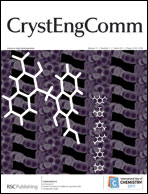The reaction of the flexible tris-phosphonate precursor benzene-1,3,5-tris(methylenephosphonic acid) (H6btmp) with CuCl2·2H2O in H2O under hydrothermal conditions afforded the complex [Cu3(btmp)(H2O)3.6]·H2O (1·H2O). A similar reaction between 2,4,6-trimethylbenzene-1,3,5-tris(methylenephosphonic acid) (Me3-H6btmp) and Cu(NO3)2·3H2O or Co(NO3)2·6H2O gave the complex [Cu4(Me3-H2btmp)2(H2O)4] (2) or [Co6(Me3-btmp)2(H2O)4] (3), respectively. The cis,trans,trans-conformation of the flexible tris-phosphonate ligands resulted in the formation of 3D networks 1 and 3. Interestingly, the cis,cis,cis-conformation of the Me3-btmp ligand in 2 results in the formation of M4L2-type copper-based metalloprismatic cages, which can serve as building units for subsequent assemblies with phosphonate (P–O) linkages to afford a 2D array of nanocages. The magnetic study indicated that complexes 1·H2O, 2 and 3 all exhibit antiferromagnetic behaviors. Interestingly, results from alternating current (ac) magnetic susceptibility measurements revealed that complex 3 exhibits slow magnetic relaxation behavior at low temperatures.

You have access to this article
 Please wait while we load your content...
Something went wrong. Try again?
Please wait while we load your content...
Something went wrong. Try again?


 Please wait while we load your content...
Please wait while we load your content...